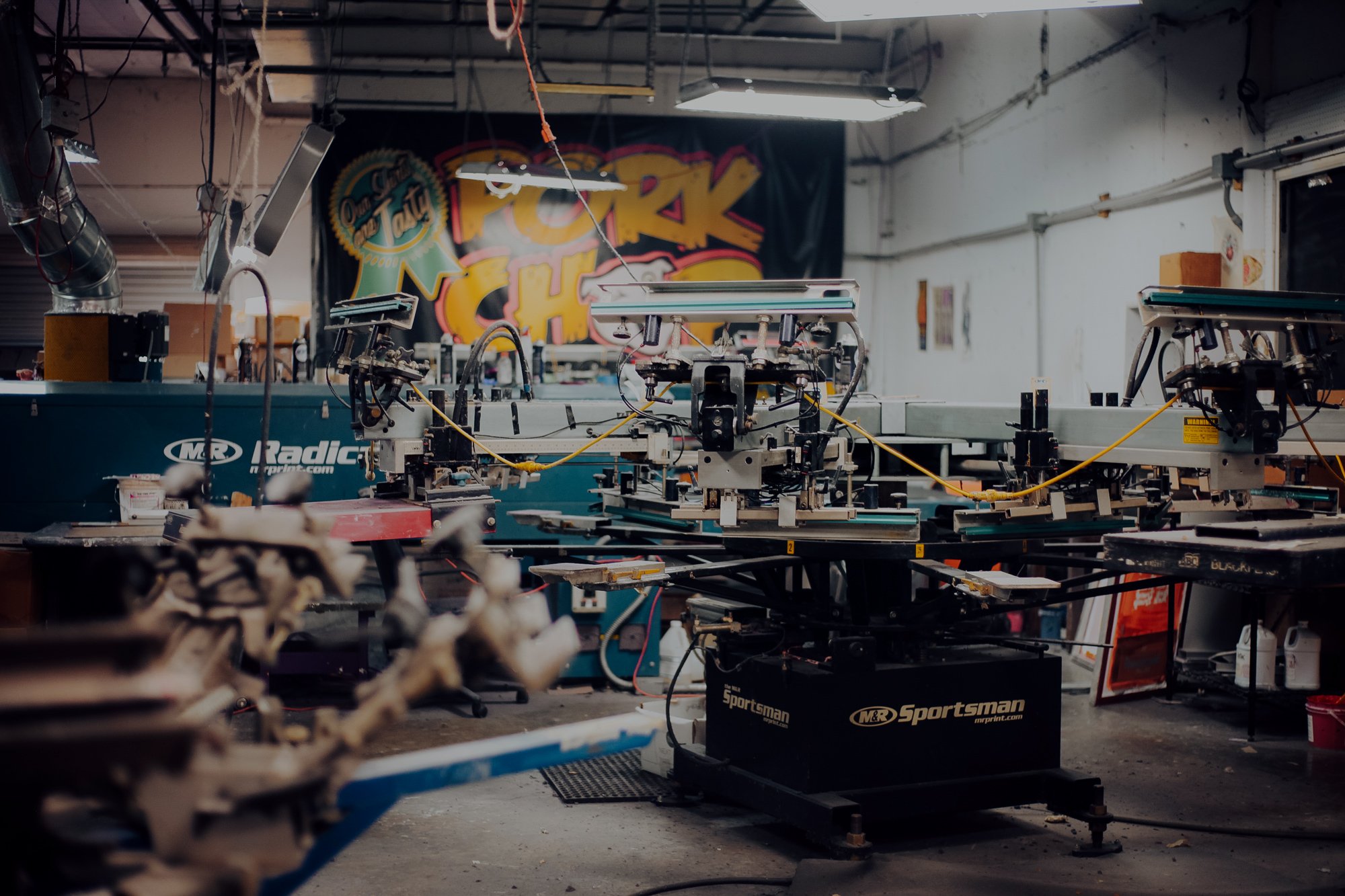Affordable Screen Printing Kit for Home Use
Display Printing Uncovered: Every Little Thing You Need to Understand About T-Shirt and Garment Printing Techniques
Screen printing is a fascinating technique that integrates art with method, using limitless opportunities for imagination. Prepared to explore the essential aspects that make screen publishing an art form?
The Fundamentals of Screen Printing: How It Functions
When you dive into display printing, you'll discover it's both a scientific research and an art. At its core, screen printing includes creating a pattern, or screen, that enables ink to pass through just in certain locations.
Setting the display over the material, then use a squeegee to press ink via the display onto the garment. Each step is crucial, and mastering them will boost your screen printing skills, changing straightforward garments right into distinct, meaningful items.
Sorts Of Display Printing Strategies
Once you understand the essentials of screen printing, it's time to check out the different methods that can boost your styles. One preferred technique is traditional screen printing, where ink is pushed with a stenciled display. This strategy is fantastic for bold, dynamic colors. After that there's water-based ink printing, which uses a softer feeling and is environmentally friendly, yet it calls for a different technique to healing.
Another choice is plastisol printing, understood for its sturdiness and vibrant shades, making it a favorite for many brand names. Experiment with halftone printing to create gradient results and complex designs.
Important Tools for Screen Printing
To attain sensational cause display printing, having the appropriate equipment is fundamental. First, you'll require a durable display printing framework, which holds the mesh that transfers your design onto the garment. Next, buy top notch squeegees; these are crucial for applying ink evenly across the display. You'll additionally call for a good exposure device to create your displays, as well as a washout booth for cleansing them after use. A trustworthy warmth source, like a conveyor dryer or warm press, is vital for healing your prints to guarantee durability. Do not fail to remember a correct workspace, furnished with tables and storage space for your materials. Ultimately, safety gear, such as masks and gloves, will certainly maintain you secure from chemicals and inks. With the right devices, you'll be well on your method to producing professional-quality prints.
Selecting the Right Inks and Products
When selecting inks and materials for screen printing, you require to think about the kind of ink that functions ideal for your task. Believe concerning material compatibility to ensure your styles look fantastic and last long. Explore environmentally friendly ink options to make your printing process more lasting.
Sorts Of Screen Inks
Selecting the ideal display ink is vital for accomplishing vibrant, resilient prints that meet your task's requirements. There are several types of display inks to take a look at. Plastisol ink is prominent for its flexibility and simplicity of usage, giving exceptional color opacity on dark fabrics. Water-based ink, on the various other hand, offers a softer feel and is eco-friendly, making it suitable for those seeking to reduce their ecological effect. Release inks eliminate color from the material, resulting in a soft, vintage look yet require details handling. Specialty inks, such as glow-in-the-dark or metallic, can add unique impacts to your layouts. Evaluate your job requirements and choose the ink that straightens finest with your desired outcome.

Material Compatibility Considerations
Comprehending material compatibility is important for accomplishing high-grade display prints, specifically considering that different materials react distinctly to numerous inks. When choosing inks, think about the material type-- cotton, polyester, or blends. For cotton, water-based inks function well, supplying gentleness and breathability. Polyester, on the various other hand, commonly needs plastisol inks for much better adhesion and dynamic colors. If you're publishing on blends, you may need to make use of a mix of both types. Always evaluate your inks on sample material to guarantee they stick effectively and preserve color honesty. In addition, remember that textile weight and texture can impact the last result, so selecting the best ink and material combination is important for your task's success.
Eco-Friendly Ink Options
Environment-friendly inks are coming to be a prominent selection for display printers that desire to decrease their ecological influence while keeping quality. When selecting inks, think about water-based inks, which are much less unsafe and easier to cleanse up compared to traditional solvents.
Additionally, look for inks made from renewable energies, such as soy or vegetable-based choices. By choosing the best inks and materials, you'll not only produce sensational styles however likewise add to an extra lasting printing procedure. Make the switch, and your prints will reflect your dedication to the atmosphere!
Preparing Your Style for Screen Printing

Submit Format Needs
To assure your layout looks sharp and lively on material, you'll need to pay close interest to file format requirements for screen printing. Make sure your design has a clear background to stop undesirable white sides on your prints. Maintain color modes in mind; CMYK is common for display printing, so transform your RGB makes accordingly.
Color Splitting Up Strategies
Shade splitting up is a necessary step in preparing your layout for screen printing, and mastering it can considerably enhance your print quality. You'll need to break your design right into private colors, as each color requires a separate display during printing. This accuracy not only assures precise shade representation yet additionally enhances the printing process.
Resolution and Size
Achieving the finest lead to display printing starts with assuring your design has the appropriate resolution and dimension. Ideally, your art work ought to be at least 300 DPI (dots per inch) for sharp, clear prints. If you make use of lower resolution, your last item may look amateur and pixelated.
When it involves size, consider the measurements of your print area. Style your art work to match the last print dimension, preferably creating it in the real measurements you'll be printing. This method, you'll prevent any unanticipated scaling concerns.
Always examine your style in both vector and raster styles. Vector graphics can be scaled without shedding quality, making them optimal for screen printing. Preparing appropriately will assure your layout looks outstanding on every garment!
Step-by-Step Display Printing Refine
Screen printing is a dynamic procedure that enables you to produce dynamic styles on various surfaces. To get started, you'll require a display, emulsion, and your selected ink.
Pour ink this contact form onto the screen and make use of a squeegee to push the ink through the pattern onto the textile. Raise the screen meticulously and let the print dry. You've successfully display published your design.
Tips for Effective Screen Printing Projects
While you're diving right into your display printing tasks, bear in mind that preparation is key to success. Beginning by gathering all your products-- inks, garments, squeegees, and screens. A tidy work space assists avoid undesirable errors, so clean up prior to you start.
Following, validate your artwork is high-resolution and appropriately sized for your garment. Evaluate your display for appropriate direct exposure and tidy it thoroughly to prevent spots. When blending your inks, comply with the manufacturer's standards to attain the best uniformity.
Throughout printing, apply also stress with your squeegee for consistent outcomes. Don't hurry; take your time to verify each print satisfies your criteria. After printing, let your garments dry completely before dealing with or packaging them.
Lastly, always keep a sample of your help future reference. This method, you can evaluate your progression and improve your techniques gradually. Satisfied printing!

Regularly Asked Concerns
The length of time Does It Take to Establish a Display Printing Task?
Setting up a screen printing job usually takes about thirty minutes to an hour. You'll prepare the screens, mix inks, and adjust the press. The time varies based on complexity and experience, so remain arranged!
Can I Print on Different Textile Keys In Making Use Of the Same Technique?
Yes, you can publish on various material types using the exact same technique, yet you'll require to change view it now your inks and settings. Some materials absorb ink in a different way, so experimenting guarantees the most effective outcomes for every product.
What Prevail Mistakes to Stay Clear Of in Screen Printing?
When screen printing, avoid usual errors like using the wrong ink, overlooking proper direct exposure times, or skipping pre-press checks. Constantly evaluate your configuration and maintain tidy screens to assure high quality outcomes each time.
Exactly How Can I Correctly Tidy and Preserve My Display Printing Devices?
To appropriately clean and keep your display printing equipment, you need to routinely wash displays with suitable solvents, examine squeegees for wear, and ensure all tools are saved dust-free and completely dry. Consistency boosts and avoids expensive repairs performance.
Is Screen Printing Eco Friendly Compared to Other Methods?
Display printing can be extra eco-friendly than various other techniques, especially if you make use of eco-conscious products and water-based inks. By choosing sustainable supplies and methods, you decrease waste and reduce your impact on the earth.
Display Printing Uncovered: Everything You Need to Know Regarding Tee and Garment Printing Strategies
At its core, display printing involves producing a stencil, or display, that permits ink to pass through only in details locations. Position the screen over the material, after that make use of a squeegee to press ink through the screen onto the garment. One popular technique is traditional screen printing, where ink is pushed through a stenciled screen.When choosing inks and materials for display printing, you require to take right into account the kind of ink that functions finest for your task.